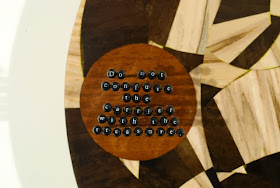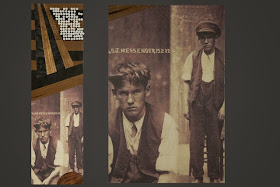Image of Graham in his studio by Michael Winters from an interview found here.
"My work is an investigation of comparative relationships through personal narratives. The work intentionally wanders from traditional printmaking to furniture and everything in between including performance and installation, and kinetic sculpture. Conceptually based in storytelling I use images and elements of history as raw components. Translating these images through traditional/non-traditional processes and craft materials to engage social structures and interactions. I believe in the malleable nature of history and memory and I often rely on a process of forcing images against each other to dilate previously unscripted narratives.
There is a practice in dream therapy in dealing with partial memory where the client will start telling their dream until it gets unclear what happens next. At this point the therapist will make up the rest. The client will contest, saying not it was not like that, but it was like this; going on to finish a dream they had up until then, forgotten. The memory comes forward to defend itself. I serve as both the client and the administrator forcing comparisons in hope of a defensive dialog coming forward to defend the visual narrative of each personal investigation." -J. Daniel Graham
What is your medium for creating a work of art? I am a sculptor and printmaker. I use everything from wood to metals and multiple processes in printmaking like screen printing, etching etc.
Describe your journey as an artist, how did you start out, what keeps you going, how did you come to love the medium you use? Funny super long story but the short version was that I tried to take art in High School and they said it was “for serious artists only” and so my first art class was in college and it changed the course of my life. Since then I have traveled the world doing what I love. Currently I am a Sculpture and Printmaking Professor at Georgetown College in Kentucky.
Describe the process you take in creating your work. What helps you get in the zone? Usually I hear something or experience something that sparks a snowball of thinking that leads to working. When it comes to working, I just love the whole process from start to finish so its always just how much time I can get into it before I have to be doing something else.
When and where do you work best? I love mornings. I like taking advantage of time that others don’t. When I was in college all my friends would stay up super late and pull all nighters I would just come in real early every day since usually no one was there. At one point in life I worked on a golf course mowing grass and we had to be there at 4:00am to start working and it really made me like working in the dark and watching the sun come up rather than going home in the dark.
How do you get out of an artist block when you’re not feeling creative? That is usually just an issue of time and getting out of the studio. I always like the saying that “Amateurs get inspired, professionals get to work.” It’s quite true on a lot of days that it’s just a fight to think creatively but it is a fight worth having and not waiting on something to “strike”.
What is it you love about art? I love the flexibility and I love the never-ending rabbit hole of knowledge and process. Also I love talking with people and seeing what people from all over are able to think of and accomplish.
What is your favorite subject matter? I love working with historical images and machines.
Who is your favorite all-time artist? That’s an impossible question…depends on the day really. I look at a lot of artists rather than thinking of any as particular favorites. In this way I really hope avoiding being compared to anyone.
Who inspires you (past or present) and what is it about them or their work that touches you? So many people but here are a few that have really stuck with me. Monika Lidman, Arthur Ganson, Bob Mueller, Martijn Van Wagtendonk, Ron Mueck, Peter Rollins, Oldrich Kulaneck, Rebecca Horn, Ann Hamilton, and Robert Smithson.
What is it about the process of creating artwork that gives you joy? I love cutting a smooth line or nice curve, I love craft and being precise. Something about crazy ideas coming from seemingly nowhere and getting to a place of precision is something that is very fulfilling.
What influence do you hope to have on others? I hope to make people think about what they are looking at. To think about how things are made and how that has an impact on our everyday interactions with objects and especially art.
Are you more about aesthetic, art for art’s sake, or do you like to have a deeper meaning and symbolism to your work? How do you accomplish this? I am much more of a concept based artist but I by no means neglect the aesthetics of the work. I let the idea drive the work to its aesthetic outcome.
How would you define your individual style, how did you find your artistic voice? I use traditional materials and traditional techniques found in printmaking and woodworking but I use them to alternative ends. It is ever changing because we as people constantly change. I think it is sad when artists stop playing and experimenting and stick to one thing.
What makes your style different or recognized as yours? I think craft and traditional materials and processes used in non traditional ways seem to set me apart.
How have you evolved as an artist? I used to make work without the material or the viewer really in mind. I made work for me. Now I make work for both me and the viewer. I think that has been one of the biggest evolutions over my time in the arts.
Where did start out? I went to The University of Florida with Civil Engineering in mind as a major but I always loved to draw and make things. I grew up in a home where we were always fixing and making things. My mom was a craftsperson and my dad was handy with making things work. But it was at UF where I took an art class called WARP that really changed everything. I didn’t even realize how much I didn’t fit in until I did. All of the things that people saw as problems or awkward in me were positives in my art experiences. It just felt like I stumbled into a home that I didn’t know I owned but as soon as I looked around I realized that it was made for me.
What other things are you passionate about in life that influences your artwork/process? I love to read and watch bad reality television. I have two kids and being apart of their childhood is a passion of mine for sure.
If you didn't study art, how did you learn or become an artist in your given craft? After my time at UF I moved to Washington DC and did an apprenticeship in furniture making before going back to school to get my MFA so I could teach college.
What is art to you/what does it mean to you? Wow that’s a tough one. Its kind of like asking what do your legs mean to you. It is how I move, its how I process so many things, simple and complicated. Its how I get from one place to another, and its something that just is, and you don’t really think about it till it is not present.
What style/movement do you like the most and why? I like what is being made today. I love bits and pieces from all of history but I like to see what people are doing with all that is available today. That being said there is a lot of bad stuff out there but there is some killer work as well. We forget when we look back over history that so much of that time is not documented or forgotten.
A huge Thanks to Daniel for sharing!
Don't forget to find him on facebook and instagram!






















inspiring work and words
ReplyDelete